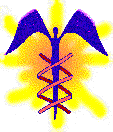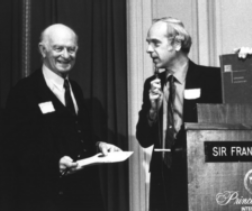

|
|
ONLY THE OVAL
BUTTONS LINK
![]()
![]()
![]()
![]()
![]()
![]()
![]()
![]()
![]()
![]()
![]()
![]()
![]()
![]()
![]()
THE ROOTS OF MOLECULAR MEDICINE: A Tribute to Linus Pauling
Edited by Richard P. Huemer, M.D.
W.H. Freeman & Co., N.Y.,
290 pp, © 1986
Based on a collection of papers presented at a 1983 symposium of the Orthomolecular Medical Society to honor Dr. Pauling; with revisions and additional manuscripts.
|
|
RPH presents Dr. Pauling with a certificate and is about to get his college chemistry book autographed. Photo by PEH, 1983 |
PREFACE
|
|
This book began as spoken words. It grew out of a symposium presented in May 1983 by the Orthomolecular Medical Society to honor Linus Pauling. This special meeting was not to celebrate Dr. |
|
Pauling's birthday or the anniversary of a special achievement or any of the other usual occasions. We just decided it was our turn to honor this man who had done so much to raise public awareness of nutrition and health and whose orthomolecular concept had guided our society and given it its name. As president of the Orthomolecular Medical Society at that time, I had the privilege of organizing the meeting and inviting the speakers. This was no easy task, since through his long career Linus Pauling had known and worked with many people and had made many friends. Alexander Rich and Norman Davidson, who had edited a festschrift for Dr. Pauling in 1968,* very kindly provided names and addresses of significant people in his life. To that list I added the names of others who were working in areas of interest to Dr. Pauling. I originally had in mind a sort of "This Is Your Life, Linus Pauling," but it was not to be. I learned that Linus Pauling's intellectual edifice had many rooms, with doors through which Dr. Pauling passed with ease, but other occupants of this mansion felt more comfortable in their own chambers. So I did not succeed in enticing any of his earlier colleagues, pure chemists and crystallographers, to our medical gathering. As I became more familiar with Dr. Pauling's remarkably varied career, I thought of Oliver Wendell Holmes's lines about the chambered nautilus:
The speakers were invited, the members of the Orthomolecular Medical Society were notified, and everyone gathered in San Francisco on May 7 and 8. Displaying no jet lag despite having just returned from speaking engagements in Europe, Dr. Pauling listened to each presentation with evident relish and attended the Saturday evening reception at Dick Kunin's elegant home. The program went off without a hitch. The society planned right from the beginning to make the proceedings of the meeting into a book, a festschrift for Dr. Pauling. However, what you see in these pages is not exactly what was presented at the meeting. Some speakers have extensively revised their papers, and two invitees who could not attend sent excellent manuscripts that I have included. Other speakers did not submit manuscripts for publication. We began to see the purpose of the book as different from that of the meeting. Whereas the symposium was intended as a tribute to a great man, the book would do double duty as both tribute and text. We perceived the book, more and more, as a means of communicating the essentials of orthomolecular medicine to our friends in other fields of practice. Thus, four chapters have been added to draw a clearer and more comprehensive picture of orthomolecular medicine. Although Dr. Pauling's work for peace and social justice is not obviously connected to orthomolecular medicine, I cannot see that it is any less important than his scientific work. I am not even sure that it can be separated from his scientific work. As discussions of it were part of our original tribute, I have included the subject in this volume. In editing this collection, I have tried to preserve the intimacy and spirit of the spoken presentations wherever I could. Thus, I have left mostly intact the authors’ personal reminiscences and comments about Dr. Pauling. I have also retained the extemporaneous remarks presented by Pauling at the end of the symposium, thereby scoring a first in publishing history: Dr. Pauling has contributed to his own festschrift! But some things cannot be set in type: emotions, such as our delight at Crellin Pauling's account of growing up with his famous father, or the comradery we felt, or our awe at viewing hemoglobin A in color and three dimensions--an ancient micro-landscape that evokes feelings you might experience in Monument Valley. Vitamin C buffs will not be disappointed by this volume, but orthomolecular medicine encompasses far more than vitamins. Practicing physicians will find particularly relevant the chapters with extensive reviews of immunology and orthomolecular psychiatry. I must admit to having been unprepared in 1983 for the emphasis placed on free-radical biology by many of the symposium speakers. Three years later it seems very appropriate and well within the mainstream. Dr. Pauling, of course, had written on free radicals back in the 1930s. I have enjoyed editing this book. The authors were usually prompt and were always tolerant of suggestions for improvement. (Fully a third of the authors, by the way, are current or former members of the Orthomolecular Medical Society.) But I edited Irwin Stone's contribution with great sadness, for Dr. Stone died from an accident in May 1984, a year after our symposium. I hope that, in polishing his words, I have not made less luminous the message he had for us. I would like to thank some people. In the early stages of this project, Ralph Buchsbaum and Ted Melnechuk provided valuable advice on book production to the neophyte editor. Gerard Piel gave the green light for publication at W. H. Freeman, and Jim Dodd took the book through its first steps. Our project editor, Susan Moran, coordinated everything, kept everyone on schedule, and did it all with good humor and tact. I thank my wife Gloria for transcribing tapes and retyping manuscripts, and my son Peter for the frontispiece photograph. Thanks are also due to the OMS headquarters staff, and particularly Ruth Cammack, for typing and symposium coordination. Most of all, I thank the contributors to this volume for giving me the opportunity to become thoroughly familiar with a wealth of fascinating information. There is something to be said for Keats's assertion that truth is beauty; there is much beauty in the truths of science, and I trust that those who read these pages will see it behind the technical words. Similar thoughts have been well expressed by Albert Szent-Gyorgyi. He was not able to come to our symposium in 1983, but in declining the invitation he wrote, in part,
That message nicely summarizes the pages that follow.
Richard
P. Huemer, MD
__________ |
| . | |

